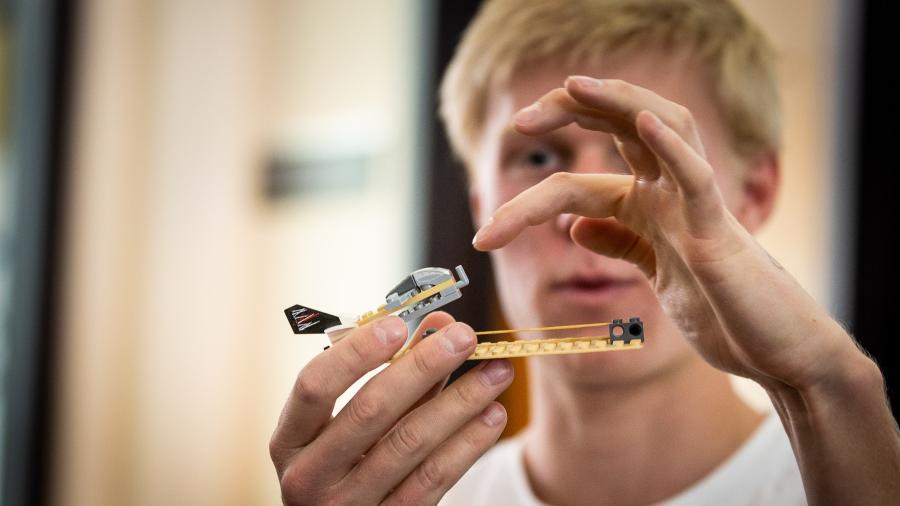Westmont Magazine Engineering Builds Out Its Program

Westmont’s engineering program welcomed more than a dozen impressive professional engineers to campus for two days of meetings and feedback on the young program. The Westmont Engineering Advisory Board explored ideas about the department’s curriculum, design projects, accreditation and funding.
“We talked quite a bit about creating a culture in the engineering program that helps students grow not only technically, but in every aspect — including their spiritual lives,” says Dan Jensen, director of the engineering program.
The group, consisting of talented representatives from Microsoft, Northrup Grumman, National Center for Atmospheric Research, CIA and Compassion International, will create educational outcomes for the program as part of the accreditation process. “They’re committed to funding design projects and the yearlong senior capstone program, and they’ll interview our students for internships,” Jensen says. “This was a great way for our stakeholders to give us feedback on everything from the curriculum to facilities to finances. These people are offering our students internships, hiring our graduates and sponsoring our design projects.”
The board members supported the curriculum and the program’s three pillars: technical excellence, foundation in the Christian LIBERAL ARTS and design innovation.
“The design innovation is a thread we weave throughout the whole program,” Jensen says. “They're excited to hire students who have the Christian LIBERAL ARTS background because they believe it provides training and experience in what some people call soft skills. Those include conflict resolution and conversing intelligently about culturally relevant and difficult topics, something that engineers may not always do well."
The group also took a morning prayer retreat to the beach. “It’s so cool to have people not only share in the academic part of what we're doing but are really excited about what God is doing here, too.”
Engineering Students Innovate for the Greater Good
Westmont juniors in the Engineering Design course are creating products and processes they hope will help children and teenagers in Ecuador better understand and appreciate science, technology, engineering and mathematics (STEM). “Our goal is creating prototypes for Ecuadorian elementary and high school students to test,” Jensen says. “And if a small miracle happens, I’ll take at least some of my students to Ecuador for a few days to work with the students.”
The unique class participates in the Christian Collective for Social Innovation (CCSI), a partnership based on shared faith and values that includes Westmont, Baylor University and Compassion International, an organization that seeks to end poverty for children and help them flourish in the 25 countries where they operate.
“The class focuses on designing products using our academic horsepower to address challenges in under-resourced cultures,” Jensen says.
The new cohort of students began by engaging in a deep, empathetic understanding of the people involved. “To design well, especially in a culture that isn’t our own, we have to engage with the stakeholders in a meaningful way,” Jensen says. The Westmont students are talking with representatives from Compassion who serve in impoverished communities. They’re also watching videos of what’s already being done in underserved populations to try to enhance and motivate interest in STEM education. Then, they brainstorm and create mind maps in class. “They’re super excited and really fired up to have an opportunity to help someone in the name of Jesus,” Jensen says.
The students’ final product must meet certain criteria. “It needs to be low-cost because of the environment we’re working in,” Jensen says. “It needs to be really fun. It needs to be robust, meaning it doesn’t break easily. The instructions have to be easy to follow. And it needs to meet specific educational objectives that experts have provided for us.”
One of the primary goals is developing something that will educate and assist children and teenagers. “For example, we may
put together a kit of parts that the students assemble in fun, different ways and learn about science while they’re doing it,” Jensen says. “The ideal thing would be to locally source those kits and create an economic impact at the local level. Then we’ve helped people get jobs, and we’re teaching STEM and motivating the kids.”
Eventually, CCSI hopes Westmont’s program will serve as a prototype to attract other universities and Christian groups. “We’d like to get other academic institutions with similar faiths and values to participate so we can expand and make a significantly larger impact,” Jensen says.
Small Cars Offer Big Lessons
Small remote-controlled cars zipped along the road in front of Kerrwood Hall in December. Students in Jensen’s Machine Design course raced their foot-long RC cars on a short figure- eight racetrack as part of their coursework. “Engineering is so hard that you have to have some fun,” Jensen says.
A few cars collided and went airborne, landing on their roofs, and one lost its tire. But when the dust settled, teammates Carlos Potrero and Josh Guinto emerged as the winners.
The students created the cars from kits with hundreds of parts. “It was very complicated,” Guinto said. “We got to build everything from the shocks to the tires, and we learned how it all works: the differential and slipper knots.”
“It’s a challenge for them to manufacture the cars while learning about power transfer and suspension systems, but it’s a lot of fun,” Jensen said. “Every car worked, and that’s a huge accomplishment.”




